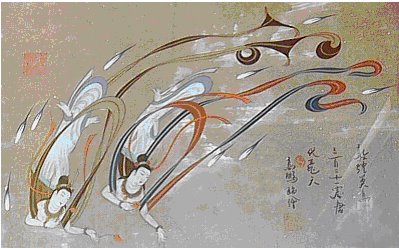[ . BACK to DARUMA MUSEUM TOP . ]
. sennin 仙人と伝説 Legends about Immortals .
::::::::::::::::::::::::::::::
Sennin no shokuji 仙人の食事 Food of the Sennin
The Elixir of Life and Immortality
仙人は霞を食べて生きている Sennin have been eating dew and mist . . .

. kuko no mi クコの実 Lycium rhombifolium .
Chinese wolfberry, goji berry, barbary matrimony vine, bocksdorn, Duke of Argyll's tea tree, or matrimony vine.
Wolfberries have long played important roles in traditional Chinese medicine where they are believed to enhance immune system function, improve eyesight, protect the liver, boost sperm production and improve circulation, among other effects.
- wikipedia
..............................

chorogi チョロギ Stachys affinis
commonly called crosne, Chinese artichoke, Japanese artichoke, knotroot, and artichoke betony, is a perennial herbaceous plant of the family Lamiaceae, originating from China.
Its rhizome is eaten as a root vegetable.
..............................
道の駅「久米の里」Roadside station Kume-no-sato
563-1 Miyao, Tsuyama, Okayama
They sell special food items for Sennin in the 仙人館 Sennin Kan hall:

for example
仙人みそ Sennin Miso paste.

道の駅久米の里「仙人まつり」Sennin Matsuri Festival
In honor of the Immortal Kume Sennin they sell a lot of special food and even make
久米仙人の人形焼き waffles of Kume Sennin.

. Kume no Sennin 久米の仙人 .
. kanpooyaku 漢方薬 Chinese medicine .
Kanpo, Kampo . . .
In the times before the advent of modern Western medicine, Asia relied heavily on the use of traditional remedies, medical plants and minerals and then prayers to the various deities !
::::::::::::::::::::::::::::::
- quote -
Immortality, the Elixir of Life and the Food of the Gods
When we look into the accounts of many different mythologies and religions, it becomes clear that the gods are either immortal or live a life of many thousands of years. What is rarely mentioned is the fact that in ancient religious texts there is reference to their immortality or longevity being connected to a specific kind of food that only the gods are allowed to eat. The gods were required to eat this food regularly to maintain immortality, power and strength. Many references also refer to the fact that if mortals ate this food, they would also become immortal like the gods. So let us explore the mythology surrounding this 'Elixir of Life'.

One of the main references to the food of the immortals can be found in Greek mythology.
It is written in the stories of the Greek gods that ambrosia and nectar was the food and drink of the immortal gods and this first appears in the Greek mythology relating to the birth of Zeus. Before the 'invention' or 'discovery' of ambrosia and nectar by the gods, it was written that they would feed by 'sniffing' the vapours of their dead enemies, as if they would feed from the energy of the dead souls.
- snip snip -
In the Hindu religion,
the gods would harness a milk called Amrita, a nectar that was collected and drunk by the gods to give them immortality, but forbidden for humans to drink. This milk was apparently surrounding the Earth, and the gods would collect it with the help of a serpent.
In Chinese mythology
we have the 'Peaches of Immortality' as the food of the immortals. Eating this food ensured the everlasting existence of the gods. If humans would eat from this fruit they would also become immortals.
- snip snip -
Nectar and Ambrosia, the Tree of Life, Amrita, Peaches of Immortality, Soma and Haoma –
are all these references simply the imagination of our ancient ancestors? Or, like other myths, is there an element of truth to be found in these ancient tales? It is possible that immortality or longevity can really be achieved through the consumption of a 'special' food, which has always been held as a privilege reserved for the gods? Perhaps the search for the 'Elixir of Life' is a valid and one day it may be found ...
- source : John Black -
..............................

- quote -
Seeking Life but Finding Death: Deadly Chinese Elixirs of Immortality
..... These elites would normally patronize Taoist alchemists, who would provide them with some sort of substance that would supposedly give them immortality. The ingestion of such elixirs, however, certainly did not allow them to live forever. In many cases the elixirs, which contain extremely poisonous elements, (ironically) were responsible for the deaths of those who consumed them. .....
Chang'e and the Elixir of Immortality
The elixir of immortality is a concept that can be found in Taoist mythology. .....
Recipes for Immortality
..... One example of the former is the Lingzhi, which has been translated literally as the 'Supernatural Mushroom' and known also as the 'Mushroom of Immortality'. .....
Death by an Elixir of Immortality
..... The most famous Chinese Emperor to have died by taking the elixir of immortality, however, is Qin Shi Huang, the first emperor of China. The emperor's obsession with attaining immortality is well-known in Chinese history and was recorded by ancient Chinese historians. .....
- source : theeventchronicle.com/
::::::::::::::::::::::::::::::
- further reference -
::::::::::::::::::::::::::::::
. sennin 天狗と仙人伝説 Legends about Tengu and Immortals .
. sennin 仙人と伝説 Legends about Immortals .
. Japan - Shrines and Temples - Index .
[ . BACK to DARUMA MUSEUM . TOP . ]
[ . BACK to WORLDKIGO . TOP . ]
- - #senninfood #elixiroflife -
::::::::::::::::::::::::::::::
--
Posted By Gabi Greve to Heian Period Japan on 3/29/2018 09:31:00 am

































